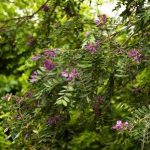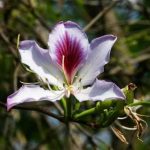TREE LIFE
March 2003
WHILE THE CURRENT FUEL CRISIS PERSISTS IT IS IMPORTANT TO CONFIRM WITH ANY OF THE COMMITTEE MEMBERS THAT THE SCHEDULED OUTINGS AND WALKS CAN ACTUALLY TAKE PLACE. SEE THE BACK PAGE FOR PHONE NUMBERS.
Annual subs are now due for 2003/04. Please pay your $1500 promptly if possible, as this would greatly help the financial situation of the Society.
MASHONALAND CALENDAR
Tuesday 4th March: Botanic Garden Walk with Tom Müller. Meet in the car park at 4.45 for 5pm. The subject will be Acacias.
Sunday 16th March: Ruzawi School, which is our venue in the Marondera area. This is a return visit to some lovely unspoilt woodland in a very scenic area.
Saturday 22nd March: Mark’s Walk will be in a lesser known area of the Mukuvisi Woodlands. Meet in the car park at 2.30 pm as usual.
Tuesday 1st April: Botanic Garden Walk.
MATABELELAND CALENDAR
Nothing has been arranged for March.
BOTANIC GARDEN WALK: 7 JANUARY 2003
Gamely led by Tom, who had a very painful leg, the subject today was the subfamily Caesalpinioideae of the legumes.
This is one of the three subfamilies of the Fabaceae and it is sometimes treated as a family in its own right, namely the Caesalpiniaceae. For someone like me who grew up in Europe, these trees were an almost totally unfamiliar concept when I first saw the Zimbabwean flora. The pea-flowered subfamily, the Papilionoideae are common in Europe; the other the Mimosoideae (acacias and so on) are also rare but I had seen planted acacias and had some vague idea of the concept. But things like the Msasa have no close relatives at all and seemed very strange indeed.
The trees are important in Zimbabwe because a number of important vegetation types are defined by the presence of these trees: think of miombo woodland (Brachystegia and Julbernardia), mopane, Baikiea and Erythrophleum.
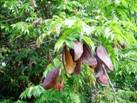
Erythrophleum suaveolens. Photo: Mike Bingham. Source: Flora of Zimbabwe
Our first port of call was Erythrophleum suaveolens, the Forest ordeal tree. Tom pointed out how this is a low altitude tree, sometimes enormous, of riverine and coastal habitats. He also made the interesting point that in Zimbabwe there is usually a clear distinction between rain forest and woodland; however in Mozambique as you approach the high lands, there are often mixed forest/woodland types. This tree has very large 2-pinnate leaves with alternate leaflets and thick hard pods, somewhat like those of the Msasa. The flowers grow in catkins, rather like those of Burkea.
The other species we get in Zimbabwe is the Ordeal tree, Erythrophleum africanum, best known from Kalahari sand. Tom pointed out that it also grows in miombo woodland on karroo sand.
As a general rule, this species never succeeds in the Botanic Gardens because of the unsuitable soils.
However, one specimen of an Erythrophleum sp. close to E. africanum does grow well there. We looked at this specimen, which came from Ngundu Halt. Not only does it grow where it shouldn’t but it also somewhat different in appearance in that its leaflets are more acuminate than the usual species and also more velvety. Attempts have been made to match it with other species but so far without success and its status remains a mystery.
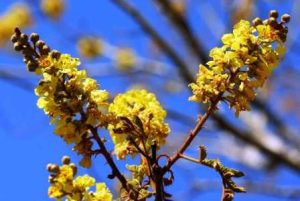
Peltophorum africanum. Photo: Bart Wursten. Source: Flora of Zimbabwe
Another 2-pinnate-leaved species in the family is Peltophorum africanum (the African wattle). This is a common and well-known species, often very striking with is conical inflorescences of yellow flowers, It is tolerant of a wide range of altitudes and habitats but generally does not occur in the drier types of lowveld. The leaves are often brown-hairy and bear the typical compound stipules. The fruits are flat and 1-seeded.
Schotia capitata is one of the rarest trees in Zimbabwe, having been found only once by Bob Drummond in Gonarezhou. The leaves and flowers look quite like the widespread S. brachypetala which we see quite often; however the leaves are fewer, smaller and more rounded.
Schotia brachypetala (Fuchsia tree) is often a riverine species in the lowveld but occurs on anthills when it occurs in the highveld. It is very impressive when in full flower. One feature of the leaves is that the rachis is often winged.
Finally, we looked at some of the species of Brachystegia and in particular the very rare Brachystegia manga. This species has been found only near Kanyemba; it is basically a Zambian species which just reaches this country. The leaves have 4 pairs of leaflets per leaf on average.
Tom noted how the leaves of all the brachystegias were closing up as evening came on – the reason being the failure of the group to attain double figures – we were only 7 plus Tom.
Once again – many thanks to Tom for a fascinating walk.
-Mark Hyde
TWO TRIPS TO THE RAINFOREST OF NYANGA Part 1
INTRODUCTION
Rainforest can be considered the ultimate stage of the conquest of land by the Plant Kingdom. It occurs were climatic conditions are equable with no frost and regular availability of water. Zimbabwe falls within the pan tropical belt of summer seasonal rainfall and has a prolonged dry season of 6 to 8 months. Rain forest is, therefore, extremely localized, and is found mainly on the windward slopes of the mountains along the eastern border with Mozambique. The total area covered by rainforest was calculated to be 10635 ha, or approximately 106 km2, (less than 0.028% of the country). Where rainforest occurs, annual average rainfall is at least 1200 mm with appreciable precipitation, (mist and rain), during the dry season. The important factor which determines presence or absence of rainforest is the quantity and frequency in which water is available during the dry season. The rainforests of Zimbabwe represent the dry end of tropical and sub-tropical rainforest development. They have a much lower biodiversity than the forest of the equatorial belt and their species show some xenomorphic adaptations. Physiognomically and structurally, however, they resemble tropical rainforest.
Twelve main rainforest types are recognized in Zimbabwe (Müller, 1999). Altitude is the major environmental factor which determines forest types. Other environmental variables which control species distribution are available moisture (especially during the dry season), disturbance by man, (much of it prehistoric) and to a lesser extent, soil type, aspect and topography.
Over two thirds of Zimbabwe’s forests occur in the Nyanga region (6605 ha). During the year 2002, the Tree Society organised two excursions to Nyanga, both over extended weekends, to look at some of the forest and at the plant species they contain. The first trip, from the 1st to the 4th of February was to look at the montane forest zone, and the second, from the 27th to the 30th of September, to look at medium altitude and lowland forests. Reports on what species were seen and how to recognize some of them, appeared in Tree Life 266 (April 2002) and 274 (December 2002). The present account attempts to put more emphasis on vegetation types, environmental relationships, plant community structure, and the state of the forests. In addition the sightings observed during the two visits will be related to the present classification of rainforest in Zimbabwe, reflecting also on some of the forest types which we could not see because of their inaccessibility.
THE MONTANE FOREST ZONE
The upper Montane Forest Zone was visited on the 1st February in the Nyazengu Nature Reserve.
The excursion took its place along, and occasionally diverted from, a well maintained approximately 5 km long nature trail. The trail commenced at the Nyangani Circular Drive at an altitude of slightly below 2100 m and lead at first towards and then along the southern shoulder of Nyangani, to some open grassland called the Pig’s Patch, situated about 6 km southeast of Nyanga Peak and at an altitude of 2000 m.
For the first approximately 3,5 km the path followed the base of the main south-western slope of the Nyangani Massif, leading essentially through grassland which contained a multitude of montane herbs and scattered Protea spp. Associated with rock outcrops and streams there were clumps of microphyllous shrubs and occasional trees or groups of trees.
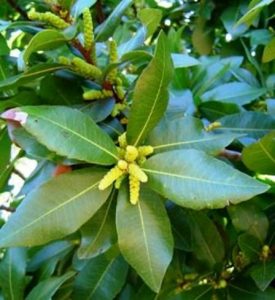
Morella pilulifera Photo: Bart Wursten. Source: Flora of Zimbabwe
The trees were Morella pilulifera, (Myrica) and a few rainforest species such as Aphloia theiformis, Nuxia congesta, Rapanea melanophloeos, Schefflera umbellifera and Widdringtonia nodiflora. Common microphyllous shrubs were Anthospermum ammannioides, Cliffortia nitidula, Clutea spp., Erica benguelensis, E. hexandra, Freylinia tropica, Halleria lucida, Hypericum revolutum, Indigofera spp., Leucocidea sericea, Myrsine africana, Passerina montana, Phyllanthus hutchinsonianus, P. myrtaceus, Rhus chirindensis, Stoebe vulgare, Tephrosia spp. and Vangueria apiculata. The endemic Morella multibracteata, a compact broad shrub, was occasionally observed.
Approximately 1,5 km further along the path the first small rainforest was encountered. It could be classified as Ilex mitis-Schefflera umbellifera-Maesa lanceolata Montane Forest. Its position was related to the flattening and broadening of the relief of a small stream bed.
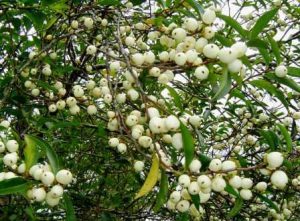
Aphloia theiformis. Photo: Bart Wursten. Source: Flora of Zimbabwe
The tree species were Aphloia theiformis, Ilex mitis, Maesa lanceolata, Podocarpus latifolius, Rapanea melanophloeos and Schefflera umbellifera. Diospyros whyteana, Psychotria zombamontana and Peddiea africana were common shrubs. A further 1 km along the path there was a practically pristine Afrocrania volkensii Montane Forest of several hectares in extent. It was associated with the flattening of a valley below some waterfalls. The forests consisted mainly of Afrocrania volkensii, a tree belonging to the Cornaceae family and which is related to plants of the Northern Temperate Zone. Other occasional tree species were Schefflera umbellifera, Maesa lanceolata, Ilex mitis and Rapanea melanophloeos. The understorey was made up of the same species as were recorded in the previous forest patch. In addition, there were Canthium kuntzeanumu, Dovyalis lucida, Gymnosporia mossambicensis, Psydrax obovata subsp. elliptica and Rhamnus prinoides. Psydrax obovata subsp. elliptica is very rare in Zimbabwe , unfortunately the specimen was lost and the identity of the plant could not be verified. Looking up the slope towards Nyangani, there were ribbon shaped patches of Widdringtonia nodiflora forest. Unfortunately, there was no time available to investigate this forest type.
Once the southern shoulder of Nyangani was reached the trail turned eastwards following some flatish land beneath the main slope coming down from Tucker’s Gap. Here the vegetation consisted of a mosaic composed of dense thickets, interspersed with open grassland and clumps of rainforest trees, which sometimes coalesced to form more continuous forest patches. The thickets consisted mainly of Hypericum revolutum. Other common woody species contained in them were Buddleja auriculata, B. salviifolia, Erica benguelensis, Isoglossa mossambicensis, Justicia betonica, Maesa lanceolata, Piper capense, Peddiea africana, Plectranthus swynnertonii, Rubus pinnatus and Sparmannia africana. The proportion in which the species occurred depended on the degree of wetness of a particular position, this created a varied pattern of species distribution. In better drained areas, single specimens or clumps of forest trees occurred, such as are Ilex mitis, Kiggelaria africana, Prunus africana, Rapanea melanophloeos, Schefflera umbellifera and Syzygium masukuense. Along drainage lines Afrocrania volkensii was present.
Looking up towards Tucker’s Gap from an area of open grassland, distinct light green patches of forest canopy were observed. These were well developed Afrocrania volkensii Montane Forests. These were too inaccessible to visit as part of the excursion, but since few people will ever have the opportunity to see them, a description of these forests is described from notes made on a previous visit. The site of the forests was on a 25 o to 35o steep boulder scree.
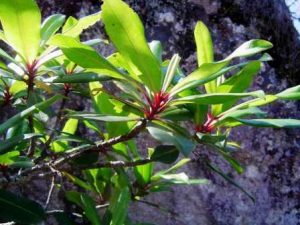
Rapanea melanophloeos. Photo: Bart Wursten. Source: Flora of Zimbabwe
The tree canopy was up to 20 m in height and consisted essentially of Afrocrania volkensii associated with occasional large specimens of Ilex mitis, Pittosporum viridiflorum, Podocarpus latifolius, Prunus africanus and Rapanea melanophloeos. There was a well developed sub-canopy which merged in places with the sapling layer. Tall specimens (up to 12 m), of Diospyros whyteana were dominant. Other common species in the sub-canopy were Peddiea africana, (up to 10 m), Kiggelaria africana and in patches Calpurnia aurea. A Calpurnia with a diameter at breast height of 60 cm, a Peddiea of 49 cm and a Psychotria zombamontana of 29 cm were measured. The well developed shrub layer consisted mainly of Diospyros whyteana, Peddiea africana, Piper capense, Plectranthus swynnertonii and Psychotra zombamontana. Occasional shrubs were Buddleja auriculata, Gymnosporia mossambicense and Vernonia wollastonii. In the ground cover, Asplenium protesum and Impatiens cecillii were dominant plants. Further ferns noted were Asplenium aethiopicum, A. monanthes, Dryopteris kilemensis, D. zanzibarica, Elaphoglossa chevalieri and Polystichum zambesiacum. Additional herbs recorded on the ground were Cyperus pseudoleptocladus, Pilea johnsstonii and the grass species Pseudobromus sivaticus. The trees were covered with epiphytes. The following were identified, Lycopodium ophioglossoides, a Streptocarpus sp., two Peperomia spp. and the ferns Elaphoglossa acrostichoides, E. kuhnii, Hymenophyllum polyanthes and Loxogramme lanceolata. The main liana was Buddleja auriculata with occasional specimens of Choristylis rhamnoides also reaching the top canopy. It was interesting to note that the waterlogging which takes place on this site during the rains preferentially selected certain species which can only grow in wet situations and are specially adapted such as Afrocrania, and others like Diospyros whyteana and Prunus africana which are more normally found along forest edges and in dry forest types. May be, that the abundance of water drives out the oxygen needed for water uptake and the plant suffers physiological drought and species with xeromorphic adaptation are more competitive in this particular niche.
Further east along the nature trail, more continuous patches of forest were found. Syzygium masukuense was the dominant tree species and other typical trees were Ilex mitis, Kiggelaria africana, Podocarpus latifolius, Prunus africana and Rapanea melanophloeos. The sub-canopy and sapling layers were most unusual in that they were dominated by Diospyros whyteana, Hypericum revolutum and Peddiea africana. To see Peddiea as a small tree with a d.b.h. of 58 cm was most unexpected. A less common small tree noted was Canthium oligocarpum subsp. captum. The shrub layer essentially consisted of Peddiea africana, Piper capensis, Psychotria zombamontana and Vernonia wallastonii. Other characteristic shrubs were Erythrococca polyandra, Isoglossa mossambicensis, Pavetta comostyla, Plectranthus swynnertonii and Rubus pinnatus. Twining in the shrub layer were Stephania abyssinica and Senecio tamoides. The ground was mainly covered by large expanses of Selaginella kraussiana, with Impatiens silvicola and Pseudobromus silvaticus also common. Other herbs recorded were Cares spicato-paniculata, Desmodium repandum, Plectranthus laxiflora and Girardina diversifolia. An interesting fern with a caudex (stem formed by an erect rhizome) of 40 cm was Diplazium zanzibaricum. Other ferns noted were Asplenium friesiorum, Athyrium schimperi, Hypolepis sparsiora and Polystichum zambesiacum. Epiphytes included the fern species Asplenium sandersonii, A. linckii, A. anisophylla, Elaphoglossa acrostichoides, E. lastii and Loxogramma lanceolata. Other epiphytes noted were Piperonia retusa and the orchids Polystachya hoelandii, P. simplex and Tridactyle inaequilonga. Choristylis rhamnoides was the common liana in the canopy.
Traversing the open area known as the Pig’s Patch, the uppermost slopes of the Chitema River catchment were reached and here the first really typical Syzygium masukuensem montane Forest was encountered. This is one of the two montane forest types which reach the highest altitude in Zimbabwe (2200 m) and is not found below 1800 m. Canopy height was 8 to 10 m with emerging specimens up to 12 m, and the dominant tree species was Syzygium masukuense. Other typical trees were Aphloia theiformis, Podocarpus latifolius and Rapanea melanophloeos. Occasional specimens of Cassipourea malosana, Macaranga mellifera and Prunus africana were also observed. The second layer was mainly formed by Peddiea africana and Canthium oligocarpum subsp. captum with young specimens of Podocarpus and Syzygium masukuense also fairly common. Diospyros whyteana occurred in scattered patches and there were very occasional specimens of Dovyalis lucida, Erythrococca polyandra, Oxyanthus speciosus, Pavetta umtalensis and Pterocelastrus echinatus. The dense shrub layer was mainly made up of Justicia betonica with scattered emerging specimens of Lasianthus kilimanschariscus, Peddiea africana, Piper capense and Psychotria zombamontana. Less common small woody plants were Asparagus setaceus, Pauridiantha symplocoides and Vernonia wollastonii. Schefflera goetzenii and Choristylis rhamnoides were occasional lianas. The ground cover consisted mainly of Pseudobromus silvaticus and Selaginella kraussiana with Cyperus pseudoleptocladus, Impatiens cecillii and Carex spicato-paniculata typical components, Drypteris kilemensis and Polystichum zambesiaca were characteristic fern species. There were also occasional non-flowering specimens of Scadoxus pole-evansii. Rocks were densely covered with lithophytic ferns such as Asplenium lobatum, Elaphoglossa aubertii, E. chevaleri, Hymenophyllum polyanthos and Loxogramme lanceolata. Common epiphytic ferns were Asplenium anisophyllum , A. rutifolium, Elaphoglossa acrostichoides, E. lastii, Hymenophyllum polyanthos , Laxogramme laceolata, Pleopeltis macrocarpa and Vittaria isoetifolia. Two Peperomia spp. were also seen on trees. Towards the dryer upper end of the forest, Schefflera umbellifera was the dominant canopy tree. In seasonally waterlogged concave portions of the slope, the spiny tree fern, Cyanthea mannana occurred in dense stands, often excluding all other woody vegetation and reaching a height of 10m.
A few people took the trail which branched off towards the top of Nyazengu Falls and from there continued to a point along the Nyangani Circular Drive, about 5 km south from where the walk commenced. After reaching the top of Nyazengu Falls this trail passed through extensive areas of Regenerating Montane Forest, a forest type which was not seen, on this day, by most of the party. These forests were probably cleared during the 19th century. The dominant tree in this high altitude Regenerating Montane Forests was Macaranga mellifera with Aphloia theiformis, Maesa lanceolata and Schefflera mellifera common or co-dominant and most of the typical high altitude forest trees were present in small numbers. Towards the end of this trail, there was a gully which contained specimens of Cyathea capensis, a tree fern which is extremely rare in Zimbabwe. It is non-spiny and tall, like C. dregei, but can be distinguished from it by the presence of Aphlebia. Aphlebia are degenerate basal pinnae with filiform segments. It also has ultimate pinna segments which are dentate and have bullate costal scales. In C. dregei the segments are entire or sub-entire and have no such scales.
The remainder of the trip was spent in the Pungwe Falls area looking at Regenerating Montane Forest, small forest remnants and forest edges, mainly between altitudes of 1880 and 1700 m, with one diversion to some forested hilltop ruins at about 2000 m. All stages of forest regeneration, from very early to relatively mature looking stands, were encountered. Two partially well developed and relatively mature Regenerating Montane Forests were visited. One was the forest which contained the large population of Scadoxus pole-evansii near the top of the escarpment, the other was situated along the path to Buvu School in the vicinity of some archaeological pit structure. The forests were similar, in both the dominant tree species was, as always in Regenerating Montane Forest, Macaranga mellifera with Aphloia theirformis and Maesa lanceolata also very common. Other canopy tree species recorded were Cassipourea melosana, Ekebergia capensis, Ficus craterostoma, Ilex mitis, Kiggelaria africana, Nuxia congesta, Pittosporum viridiflorum, Polyscias fulva, Prunus africana, Podocarpus latifolius, Rapanea melanophloeos, Schefflera umbellifera and Tabernaemontana stapfiana. Of the species seen, Aphloia theiformis, Macaranga mellifera, Maesa laceolata and Polysciasi fulva were typical pioneer species. The others can be present in successional as well as in climax assemblages. Trees recorded in the sub-canopy and sapling layer were Canthium oligocarpum subsp. captum, Diospyros whyteana, Dovyalis lucida, Garcinia kingaensis, Halleria lucida, Oxyanthus speciosus, Pavetta umtalensis, Rawsonia lucida and Trimeria grandiflora. The shrub layer, as mostly found at this altitude, consisted mainly of Justicia betonica, Peddiea africana and Psychotria pseudomontana. Other shrubs noted were Antidesma vogelianum, Gymnosporia mossambicensis, Lasianthus kilimanscharicus, Pavetta comostyla, Pauridiantha symplocoides,(in surprising abundance). Rhus chirindensis(also as a liana), Rytigynia macrula and Vernonia wollastonii. there was also a small Pavetta which was probably the newly described P. mullerii. There was an amazing array of different lianas considering that it was relatively young forest. The following were identified, Buddleya sp. ,Jasminum abyssinicum, Schefflera goetzenii, Secamone alpinii and Toddalia asiatica but there were probably a few more. It was surprising that very few young plants of Syzygium guineense subsp. afromontanum were seen considering that is this the dominant species of the climax forest in the area. Both forests were rich in woody species and had the atmosphere of relative maturity. However, the even ages of the canopy trees, their lack in age structure, the absence of really mature trees and also the absence of Syzygium guineense subsp. afromontanum pointed towards a relative young developmental age.
Reference.
Müller, T. (1999). The distribution, classification and conservation of rainforests in Zimbabwe. In: Timberlake, J. & Kativu, S. (eds) African Plants: Biodiversity, Taxonomy and Uses, pp. 221-235. Royal Botanic Gardens, Kew.
-T. Muller
BOTANIC GARDEN WALK: 4 FEBRUARY 2003
In the absence of Tom, the members who were present did a collective walk, with everyone contributing information to the subjects under discussion.
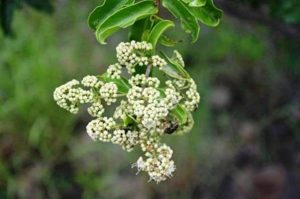
Galpinia transvaalica. Photo: T. van der Merwe. Source: Flora of Zimbabwe
The first tree we examined closely was Galpinia transvaalica. This is a rather rare tree in Zimbabwe, occurring only in the southern division. It has opposite, decussate leaves and small white, unscented flowers in terminal panicles. In my opinion it would make an interesting garden plant. Meg Coates Palgrave pointed out a distinctive feature I was not aware of, namely a “gland” on the mid vein of the leaf just below the apex. The family is Lythraceae, which in Zimbabwe mainly consists of small aquatic herbs (e.g. Nesaea and Rotala) but also has some woody examples of which Galpinia is the only native. Exotic species include the Pride of India, Lagerstroemia indica and (per some authors) the pomegranate, Punica granatum.
We also spent some time with the acacias. A large climbing acacia with flowers in spherical inflorescences and scattered prickles (and no label) caught our attention and we spent some time using Jonathan’s book trying to separate Acacia pentagona and schweinfurthii, before finally deciding it was the latter.
Nearby was Acacia eriocarpa with its large hairy leaves and pods and leaf-like stipules. This is another species, like the previous two, which have prickles scattered along the stems (i.e. not grouped in 2s or 3s). In this case, the flowers are arranged in a spike. The species occurs in the Zambezi Valley. One interesting feature was that one of the relatively large trees was producing absolutely no thorns at all; as we know from experience acacias do this from time to time and then can be confused with other Mimosoideae.

Acacia kirkii. Photo: Karl van Laeren. Source: Flora of Zimbabwe
Also present was Acacia kirkii, (the Flood plain acacia) a species new to me I must admit. This has the most extraordinary wart-covered fruits and also a distinctive bark – peeling and green underneath. According to Jonathan’s book this occurs in Zimbabwe on alluvial plains by the Zambezi river and also by the Nata river near Tsholotsho, a scattered and disjunct distribution.
Meg then led us to Acacia drepanolobium, the Whistling thorn. This is an E African species and it bears the most remarkable swollen base to the thorns, a structure known as an ant-gall. These ant-galls have holes in them which whistle as the wind blows across them.
The species also provides a classic example of an arrangement which mutually benefits both ants and plant. Certain species of ants enter and hollow out these swollen bases; there they live on the nectar provided by the acacia and actively defend the plant against attack, by either browsers or insects.
All in all, quite an interesting session. It is also good for us from time to time to have to think about what we are looking at rather than simply have Tom provide all the information!
-Mark Hyde
FUNGUS WALK: SATURDAY, 8 FEBRUARY 2003
We were very fortunate indeed to have Cathy Sharp, a well-known mycologist, to show us some of the fungi growing at Cleveland Dam. This was an extra Tree Society outing and we started early in the morning, as I understand that the fungi may disappear quite quickly in the heat of the day. After a recent dry spell, fungi were a bit hard to find and, moreover, most species seemed to be extremely well camouflaged. There was a good turnout of members and a number of representatives from Environment Africa were present.
The subject was macrofungi. Cathy explained that there were three types:
- those growing on trees;
- those growing on litter; and
- those growing on tree roots. This type are actually attached to the roots through mycorrhiza.
Another interesting point was that there are many fungi, particularly those in Brachystegia woodland, which are still undescribed. Cathy herself is actively involved in naming them, in collaboration with Belgian mycologists. This is a very different situation to flowering plants and ferns where, in Zimbabwe, the vast proportion are reasonably well known. It certainly seems to pose some additional difficulties in getting to grips with the subject.
The first fungus was a sponge fungus (a Boletus) which, under the cap, has tubes and not gills. The upper surface of the cap was cracked giving it a tortoise shell like appearance and also explained its local name makamba.
Cathy also showed us how she collects the fungi. Each one is pulled up (and sometimes cut in half longitudinally) and is then wrapped, quite loosely, in newspaper and then placed in a basket. The newspaper keeps them moist enough so that they don’t dry out before one can examine them later. Back home the fungi are then dried and preserved.
Another genus seen was Amanita. Important taxonomic features appeared to be whether there was a “ring” or not, whether the margins of the cap were striated or not and the presence or absence of gills.
There were a lot of comments and questions about whether particular species were edible or not. Interestingly, Cathy herself won’t eat them – on the grounds that they are not well enough known.
We came across a chanterelle (genus: Cantharellus), which have gills which go down the stem. According to a Swedish visitor, these are the most commonly sold type of edible mushroom in Sweden. There they are usually fried in butter and eaten on toast or in an omelet.
Many of the species seen seemed to go to great lengths to camouflage themselves. One very striking fungus of the Boletus type, had a cap which was exactly the same colour as the pods of a Msasa. And since all around it on the ground were the very pods, it was extremely difficult to spot.
Another species seen was Lactarius velutissimus. As the generic name implies, this genus oozes milk when broken – although on that day there were a bit reluctant as it was very dry. The top of the cap looks like smooth suede – which I assume explains the specific name (most velvety).
The total haul at the end of the morning was as follows:
| 2 | Amauroderma |
| 2 | Lactarius |
| 1 | Cantharellus |
| 8 | “Bolete group”. Various genera, including Boletus and Leccinum. |
| 2 | Amanita |
| 4 | Russula |
| 1 | Schizophyllum (an early coloniser of dead wood) |
| 1 | Scleroderma (puffball group) |
| 21 |
Altogether it was a most interesting morning which provided insight into a fascinating subject which was completely new to me.
Our great thanks go to Cathy and we wish her well in her future studies in mushrooms. Perhaps we might have another walk sometime?
-Mark Hyde
MARK HYDE CHAIRMAN
This issue of Tree Life has kindly been sponsored by the actuarial firm Pentact (Pvt). Ltd.


